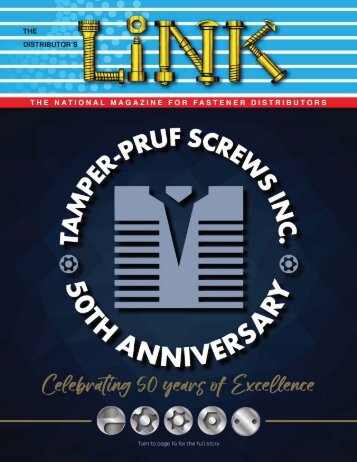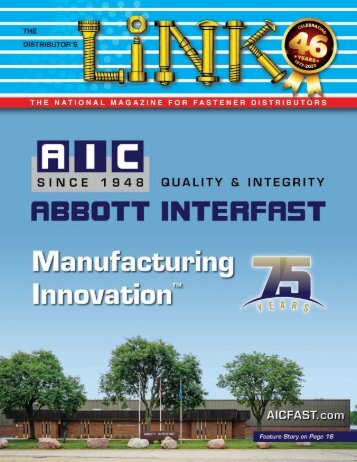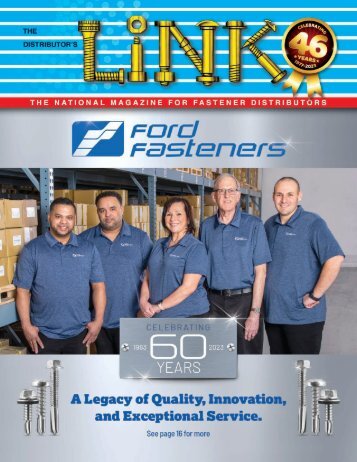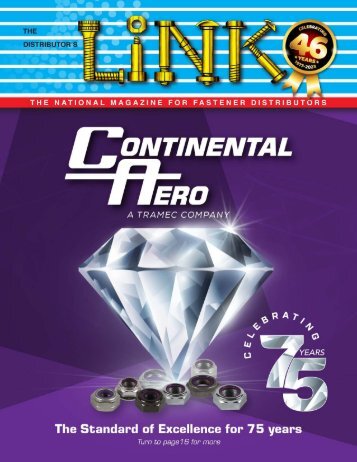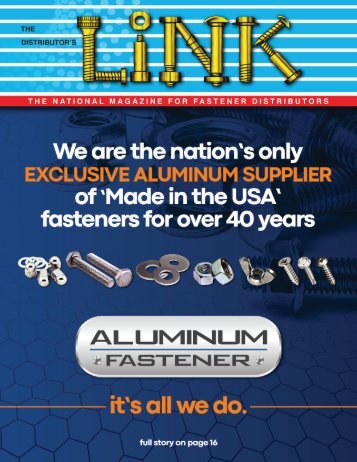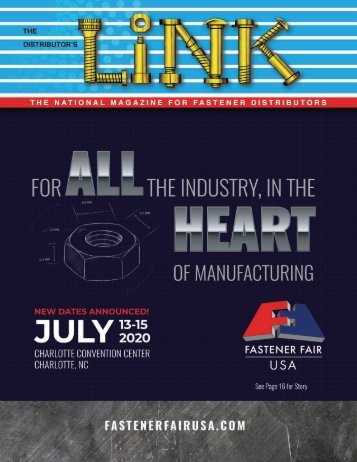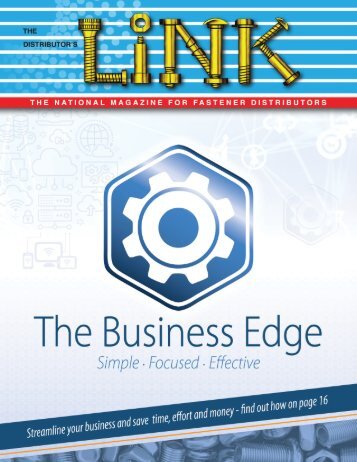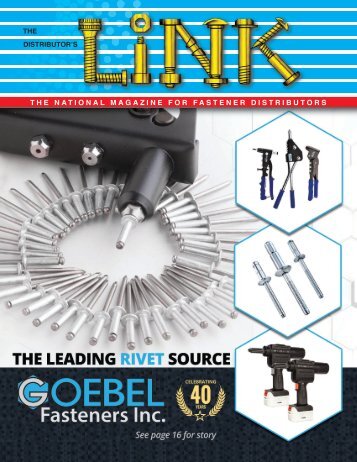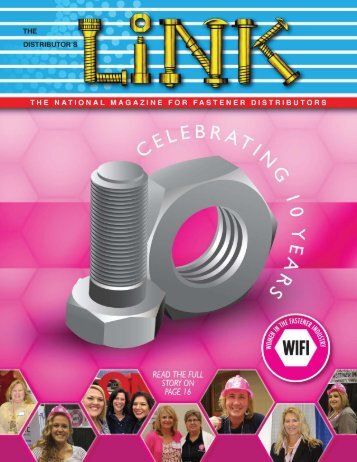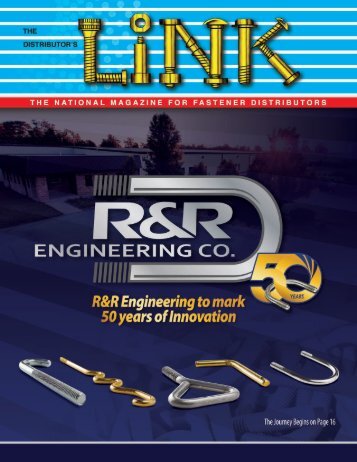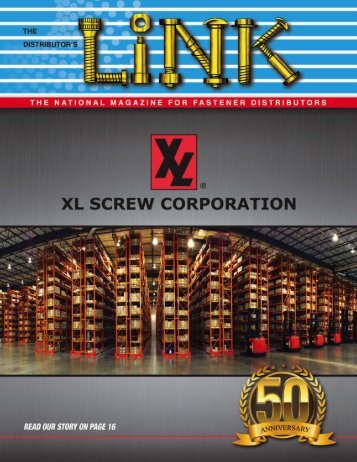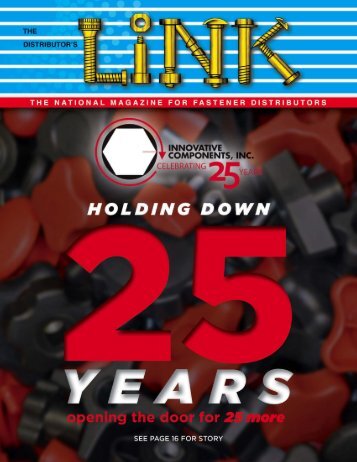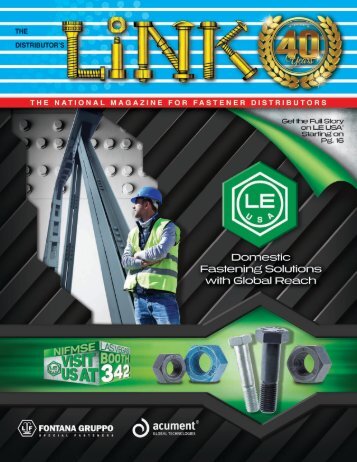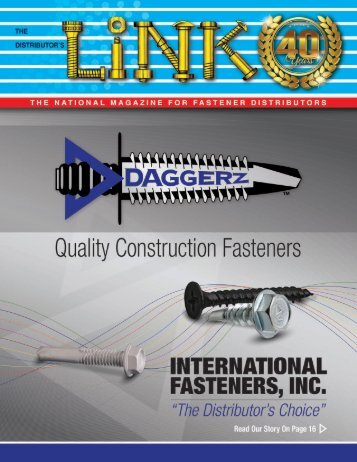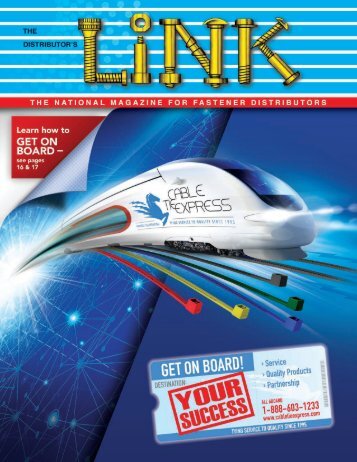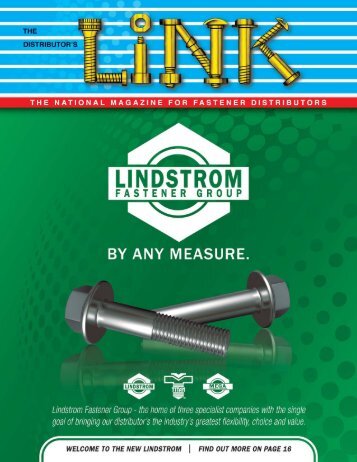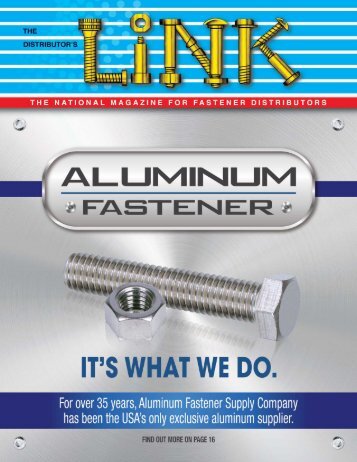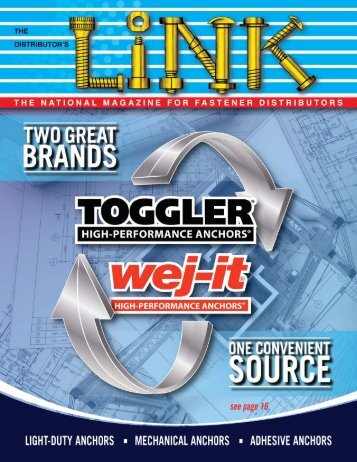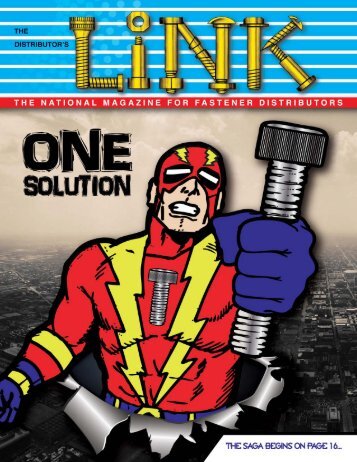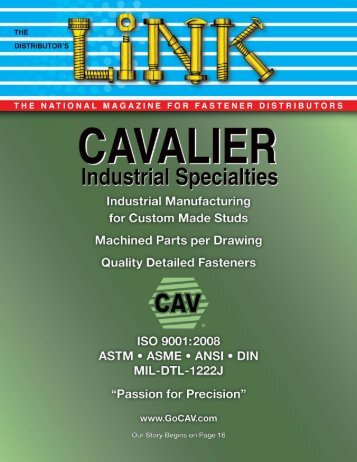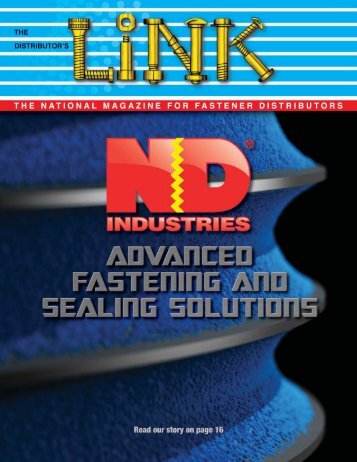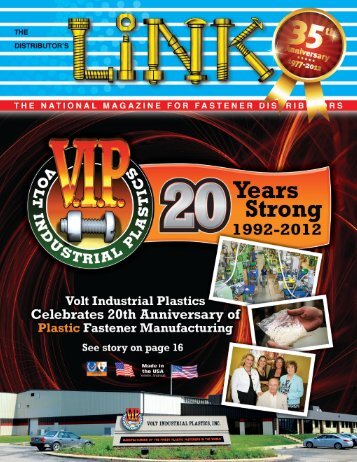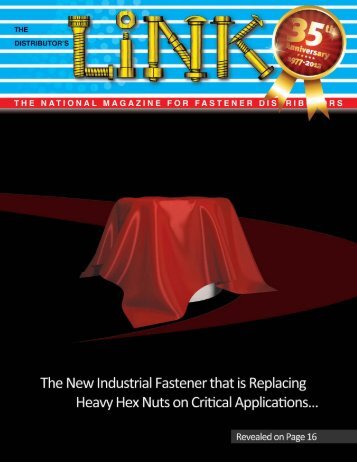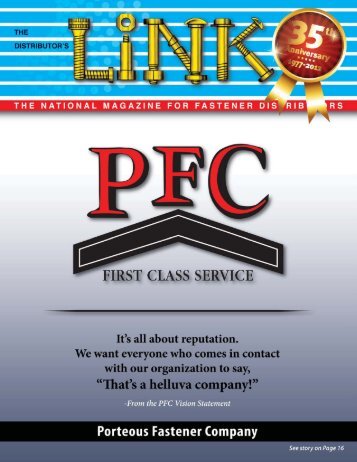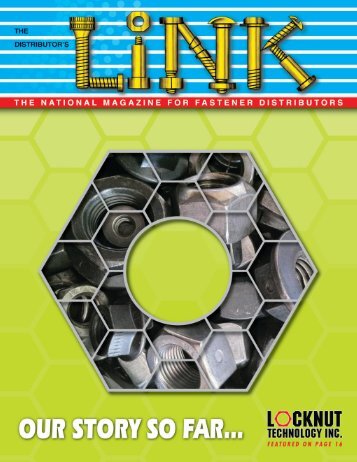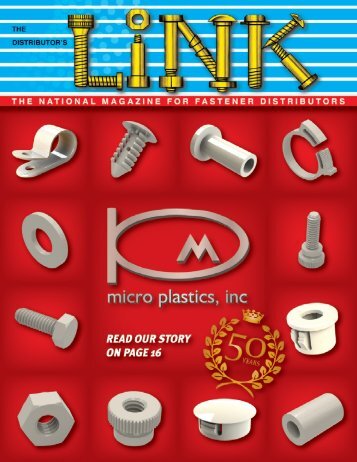WINTER 2012
- Text
- Fastener
- Fasteners
- Products
- Manufacturing
- Bolts
- Bolt
- Rivet
- Industrial
- Screws
- Distributors
42 THE DISTRIBUTOR’S
42 THE DISTRIBUTOR’S LINK STRESS RELIEF IS CRITICAL FOR MANY UNHARDENED FASTENERS by Joe Greenslade Director of Engineering Technology, IFI Unhardened screws and bolts having a minimum head thickness equal to or less than one-half the nominal screw size are susceptible to delayed failures at the head-to-body juncture if they are not properly stress relieved. Carriage bolts (round head square neck bolts) are the most common standard fasteners in this category of parts. Other commonly used unhardened standard fasteners are round head bolts, step bolts, elevator bolts, and projection weld studs. Unhardened grades of inch screws and bolts having minimum tensile strengths of 74,000 PSI or less are SAE J425, Grades 1 and 2, and ASTM A307 Grade A. Unhardened property classes of metric screws and bolts having minimum tensile strength of 600 MPa or less are 3.6 through 6.8, with the most common property classes of 4.8 and 5.8. Unhardened screws and bolts, with relatively thin heads, are susceptible to delayed failures where the head of the fastener joins its body. This susceptibility is due to the severe compaction of the steel at that location during cold heading or cold forming. This compaction, known as “cold working”, creates what is referred to as residual stresses. Cold working creates residual stresses in all cold headed parts to some extent, but the stresses are not usually detrimental in fasteners having heads thicker than one-half the nominal diameter. Because the material compaction is not as severe when the head is thicker, more volume is available within which the stresses are distributed. Potentially detrimental residual stresses are effectively alleviated by a heat treat process called Industrial Fasteners Institute 636 Oak Tree Blvd. • Independence Ohio 44131 Phone: 216.241.1482 • Fax: 216.241.5901 www.indfast.org “stress relief.” The stress relief process involves heating the cold headed parts to a temperature lower than the material’s annealing temperature (the point at which the material begins to soften) and holding the parts at that temperature for a period of time. Then the material is allowed to slow cool back to room temperature. The stress relief process must be managed as an element of the part’s process control. Unfortunately, after the parts are shipped there is no metallurgical evaluation that can determine if a part has been stress relieved. Sometimes, but not always, the need for stress relief can be determined when the parts are tensile tested before product shipment. Unfortunately, not 100% of all parts in a given lot will fail a tensile test, thus the relatively small required testing sample size may not expose the problem before the parts are put to use. The tell-tale sign that a particular lot of parts needs to be stress relieved is that the screw or bolt fails where the head joins its body, regardless of whether the parts meet the required tensile strength or not. The pictures in this article are classic examples of what tensile failures look like where stress relief is needed. Fasteners that do not have excessive residual stress due to cold working always break in the fastener’s body or thread and never at the head-to-shank juncture. If parts are breaking in the head-to-shank juncture and not meeting the minimum required tensile strength, the mode of failure will change to the body or thread and the tensile values will increase after stress relief is performed. please turn to page 154
THE DISTRIBUTOR’S LINK 43
- Page 6 and 7: THE DISTRIBUTOR’S IN THE WINTER 2
- Page 8: 6 THE DISTRIBUTOR’S LINK Nancy Ri
- Page 12: 10 THE DISTRIBUTOR’S LINK Compute
- Page 16: 14 THE DISTRIBUTOR’S LINK Jim Tru
- Page 26: 24 THE DISTRIBUTOR’S LINK Quantum
- Page 30 and 31: 28 THE DISTRIBUTOR’S LINK Robert
- Page 32: 30 THE DISTRIBUTOR’S LINK Advance
- Page 36: 34 THE DISTRIBUTOR’S LINK MFDA -
- Page 40 and 41: 38 THE DISTRIBUTOR’S LINK Bart Ba
- Page 42: 40 THE DISTRIBUTOR’S LINK MFDA -
- Page 47 and 48: THE DISTRIBUTOR’S LINK 45 PWFA -
- Page 50: 48 THE DISTRIBUTOR’S LINK Great L
- Page 54 and 55: 52 THE DISTRIBUTOR’S LINK RETAINI
- Page 56: 54 THE DISTRIBUTOR’S LINK Anthony
- Page 60: 58 THE DISTRIBUTOR’S LINK MWFA -
- Page 64 and 65: 62 THE DISTRIBUTOR’S LINK Jennife
- Page 66: 64 THE DISTRIBUTOR’S LINK Joanne
- Page 71 and 72: THE DISTRIBUTOR’S LINK 69 photos
- Page 74: 72 THE DISTRIBUTOR’S LINK Dokka F
- Page 78 and 79: 76 THE DISTRIBUTOR’S LINK PWFA -
- Page 80: 78 THE DISTRIBUTOR’S LINK Powers
- Page 86: 84 THE DISTRIBUTOR’S LINK NOW YOU
- Page 90: 88 THE DISTRIBUTOR’S LINK SEFA -
- Page 93 and 94:
THE DISTRIBUTOR’S LINK 91 WCL Com
- Page 96:
94 THE DISTRIBUTOR’S LINK Mr. Mar
- Page 100:
NATIONAL INDUSTRIAL FASTENER & MILL
- Page 104:
102 THE DISTRIBUTOR’S LINK Trinit
- Page 108:
106 THE DISTRIBUTOR’S LINK Dave K
- Page 111 and 112:
THE DISTRIBUTOR’S LINK 109 NFDA -
- Page 114:
112 THE DISTRIBUTOR’S LINK Copper
- Page 117 and 118:
THE DISTRIBUTOR’S LINK 115 LESSON
- Page 119 and 120:
THE DISTRIBUTOR’S LINK 117 FASTEN
- Page 121 and 122:
THE DISTRIBUTOR’S LINK 119 Telefa
- Page 124 and 125:
122 THE DISTRIBUTOR’S LINK ARE BA
- Page 126 and 127:
124 THE DISTRIBUTOR’S LINK GET YO
- Page 128:
photos continued on page 128
- Page 131 and 132:
THE DISTRIBUTOR’S LINK 129
- Page 133:
THE DISTRIBUTOR’S LINK 131 The Au
- Page 137:
THE DISTRIBUTOR’S LINK 135 Big Re
- Page 145:
THE DISTRIBUTOR’S LINK 143 EFC In
- Page 150 and 151:
BRIGHTON-BEST NIFS COCKTAIL PARTY T
- Page 152 and 153:
photos continued on page 162
- Page 154 and 155:
152 THE DISTRIBUTOR’S LINK BUSINE
- Page 156:
154 THE DISTRIBUTOR’S LINK STRESS
- Page 160:
158 THE DISTRIBUTOR’S LINK WORK P
- Page 164 and 165:
photos continued on page 176
- Page 166 and 167:
164 THE DISTRIBUTOR’S LINK WITUCK
- Page 168 and 169:
166 THE DISTRIBUTOR’S LINK AVOIDI
- Page 170 and 171:
168 THE DISTRIBUTOR’S LINK ADVANC
- Page 172 and 173:
NATIONAL FASTENERS DISTRIBUTORS ASS
- Page 174:
172 THE DISTRIBUTOR’S LINK EARLY
- Page 179 and 180:
THE DISTRIBUTOR’S LINK 177 FASTEN
- Page 182:
180 THE DISTRIBUTOR’S LINK D cont
- Page 186:
184 THE DISTRIBUTOR’S LINK R cont
Inappropriate
Loading...
Mail this publication
Loading...
Embed
Loading...
|
SHARE A PAGE FROM THIS MAGAZINE OPTION 1: Click on the share tab above, or OPTION 2: Click on the icon (far right of toolbar) and then click on the icon (far right of toolbar) and then click on the  icon (top right of the page). icon (top right of the page).
|
View Archives
Copyright © Distributor's Link, Inc. All Rights Reserved | Privacy Policy







